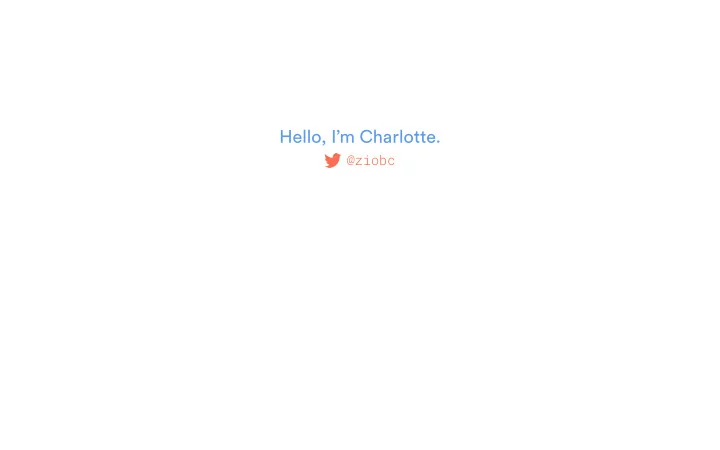

Hello, I’m Charlotte. @ziobc
Hello, I’m Charlotte. @ziobc Bochum Seattle Joburg
Ethics and Morals in Design
Ethics and morals relate to “right” and “wrong” conduct. While they are sometimes used interchangeably, they are difgerent: ethics refer to rules provided by an external source, e.g., codes of conduct in workplaces or principles in religions. Morals refer to an individual’s own principles regarding right and wrong.
My Guiding Questions Intangible and tangible products can lead to richer experiences for certain populations, but at what expense to our local/global society and to the planet? How and when does the designer learn his or her role in the negotiation of ethical considerations? How do we begin to think critically about our design process and the resulting impacts of our designs?
Ethics & morals must be considered in the fjnal designed artifact, as well as in its production process.
Victor Papanek Batya Friedman Kristy Tillman
“The designer’s...social and moral judgement must be brought into play long before he begins to design, since he has to make a judgement...as to whether the products he is asked to design or redesign merit his attention at all.” Victor Papanek
“Value Sensitive Design...is an approach to the design of information and computer systems that accounts for human values in a principled and comprehensive manner throughout the design process. While emphasizing the moral perspective (e.g., privacy, security, trust, human dignity, physical & psychological wellbeing, informed consent, intellectual property), VSD also accounts for usability (e.g., ease of use), Batya Friedman conventions (e.g., standardization of technical protocols), and personal predilections (e.g., color preferences).”
Design at its core is a manifestation of cultural values, where an artifact exists as a culmination of commentaries about its makers and his or her tools and processes. Design is not a culturally neutral endeavour–it is literally the codifying of our own norms, socializations, dysfunctions, biases, preferences, and worldviews into the harvest of our labor. Kristy Tillman The natural result is that designers play a large role in determining how other people experience and make meaning of their world.
_ Who teaches our algorithms? _ Technological solutionism _ Some little things _ What can we do?
Algorithms Technological Solutionism Little Things
Algorithms Technological Solutionism Little Things
Algorithms Technological Solutionism Little Things
Algorithms Technological Solutionism Little Things
Algorithms Technological Solutionism Little Things
Algorithms Technological Solutionism Little Things
Algorithms Technological Solutionism Little Things
Algorithms Technological Solutionism Little Things MIT Moral Machine
Algorithms Technological Solutionism Little Things “If we don’t instill ethics or morals into newly created bots, just as we do with our children, they will digest and spit back the worst of humanity unthinkingly.” - The Telegraph
_ Who teaches our algorithms? _ Technological solutionism _ Technological solutionism _ Some little things _ What can we do?
Algorithms Technological Solutionism Little Things “Solutionism interprets issues as puzzles to which there is a solution, rather than problems to which there may be a response.” - Gilles Paquet
Algorithms Technological Solutionism Little Things
Algorithms Technological Solutionism Little Things + + Food Exercise Nature
Algorithms Technological Solutionism Little Things Are we starting from the right place?
Algorithms Technological Solutionism Little Things _ Why does the US incarcerate more people than any other nation? _ How can we lessen the overpolicing of black neighborhoods? _ How do we reform sentencing of drug crimes? _ What does a robust re-entry program look like?
Algorithms Technological Solutionism Little Things Solving other people’s problems?
_ Who teaches our algorithms? _ Technological solutionism _ Some little things _ Some little things _ What can we do?
Algorithms Technological Solutionism Little Things Brent Kristen Lakisha Rasheed
Algorithms Technological Solutionism Little Things
Algorithms Technological Solutionism Little Things
Algorithms Technological Solutionism Little Things
The good news is that awareness is up, and there’s lots we can do.
Co- / Participatory Design “In « co-design » or « collaborative design » processes, design teams have members on it who are from a community-based organization or a neighborhood association. In this case, true partnerships are built between community based organizations, civic technologists, developers and designers.” - Sasha Costanza Chock, MIT
Critical/Speculative Design “Critical design takes a critical theory based approach to design. This kind of design uses design fjction and speculative design proposals to challenge assumptions, conceptions about the role of objects play in everyday life.” - Wikipedia
Reflecting as we Make “Designers and makers need more opportunities to refmect on why we make and what it means for society.” “We can’t hide behind ignorance and neutrality, and we need to be able to stand behind the decisions we make every day.” - MIT Media Lab
Engineering Code of Ethics “Engineering has a direct and vital impact on the quality of life for all people. Accordingly, the services provided by engineers require honesty, impartiality, fairness, and equity, and must be dedicated to the protection of the public health, safety, and welfare. Engineers must perform under a standard of professional behavior that requires adherence to the highest principles of ethical conduct. - NSPE Code of Ethics
Just because we can, doesn’t mean we should.
Thank you! charlotte@inquisition.co.za
Recommend
More recommend